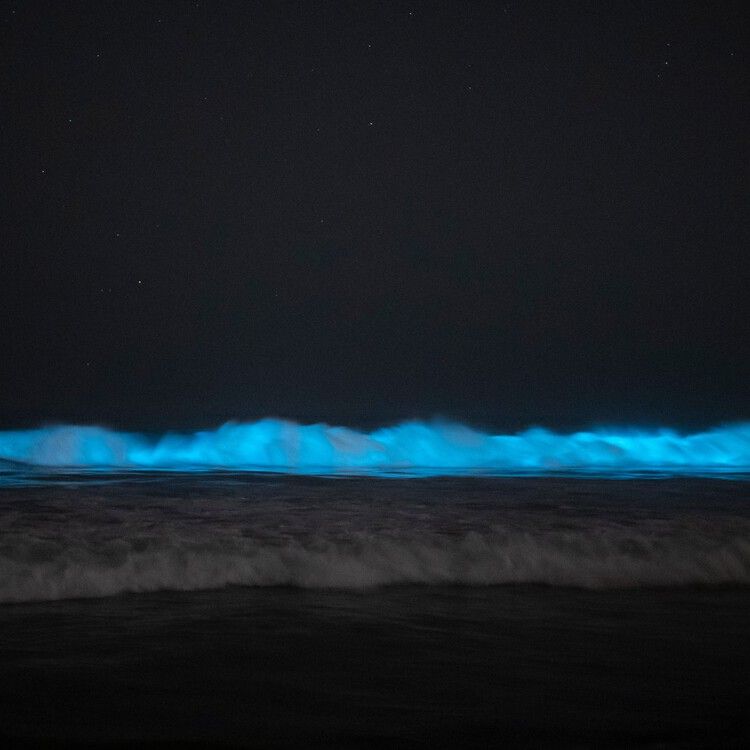Bioluminescent Wave Watching In Southern California: Spring And Fall Viewing Guide

Table of Contents
Understanding Bioluminescence in Southern California
Bioluminescence in Southern California's waters is primarily caused by microscopic marine organisms called dinoflagellates. These single-celled creatures produce light through a chemical reaction, creating the ethereal blue glow visible in the waves. The intensity of the bioluminescence depends on several factors:
- Water Temperature: Warmer waters generally support higher dinoflagellate populations, leading to brighter displays.
- Nutrient Levels: Abundant nutrients in the water fuel dinoflagellate growth, resulting in more intense bioluminescence. Recent rainfall can sometimes increase nutrient runoff, impacting displays.
- Time of Year: As discussed later, spring and fall tend to be peak seasons for bioluminescence in Southern California.
Understanding these factors influencing the ocean glow helps predict when and where you're most likely to witness this extraordinary phenomenon of bioluminescent bays.
Best Locations for Bioluminescent Wave Viewing in Southern California
While bioluminescence can occur along various stretches of Southern California coastline, some locations are consistently better than others.
Beaches near San Diego
- La Jolla Shores: This popular beach offers easy access and relatively calm waters, making it ideal for observing bioluminescence. Parking can be challenging, so arrive early, especially on weekends. Numerous restaurants and hotels are nearby.
- Coronado Beach: Known for its wide sandy expanse and stunning views, Coronado Beach also provides opportunities for bioluminescent wave watching, though the intensity might vary. Ample parking is available, but it's a bit further from central San Diego.
Beaches near Los Angeles
While less consistently known for intense bioluminescence displays compared to San Diego, certain areas near Los Angeles offer potential for sightings:
- Malibu: Some stretches of Malibu's coastline, particularly those with calmer waters, may exhibit bioluminescence, but it's less predictable than in San Diego.
- Huntington Beach: While not a primary bioluminescence hotspot, certain areas of Huntington Beach have reported sightings, though they're less frequent and intense.
Remember that bioluminescence in Los Angeles areas requires more patience and luck compared to San Diego.
Tips for Finding Bioluminescent Hotspots
- Online Resources: Check websites and local forums dedicated to Southern California nature and beaches for real-time reports on bioluminescence activity. Many enthusiasts share their observations and provide updated information.
- Bioluminescence Forecast: While not as precise as weather forecasts, seeking out any available predictions for bioluminescence can improve your chances.
- Tide Charts & Moon Phases: A new moon provides the darkest skies, enhancing visibility. Check tide charts to find calmer waters for easier observation. High tides often bring the bioluminescence closer to shore.
Optimal Timing for Bioluminescent Wave Viewing
Spring Bioluminescence
Spring months (March-May) in Southern California often offer favorable conditions for bioluminescence. Warmer water temperatures and increased nutrient levels contribute to higher dinoflagellate populations.
Fall Bioluminescence
Fall (September-November) also presents opportunities for viewing bioluminescence. Similar to spring, the water temperature and nutrient levels create a favorable environment.
Factors Affecting Viewing Conditions
Several factors can impact your viewing experience:
- Light Pollution: Minimize light pollution by choosing a location away from city lights.
- Weather Conditions: Cloud cover can obscure the bioluminescence, so clear skies are ideal.
- Moon Phase: The closer to a new moon, the better the viewing conditions will be, as the dark sky better contrasts the bioluminescence. Always check forecasts before you go.
Tips for Photographing Bioluminescent Waves
Capturing the magic of bioluminescence requires specific photography techniques:
- Long Exposure: Use a long exposure setting (several seconds to minutes) on your camera to capture the glow.
- Tripod: A tripod is essential to keep your camera stable during the long exposure.
- Remote Shutter Release: A remote shutter release prevents camera shake, which can ruin your shot.
- Dark Sky Apps: Use apps to help find locations with minimal light pollution.
Conclusion
Witnessing bioluminescent waves in Southern California is a truly magical experience. By following this guide and choosing the right time and location, you can increase your chances of witnessing this breathtaking natural phenomenon. Remember to check weather forecasts, tide charts, and moon phases before heading out, and be respectful of the environment. Plan your trip during spring or fall for the best chances of seeing bioluminescent wave watching in Southern California. Don't miss out on this unforgettable opportunity – start planning your bioluminescent adventure today!

Featured Posts
-
 Secret Service Investigation Complete Cocaine Found At White House
May 30, 2025
Secret Service Investigation Complete Cocaine Found At White House
May 30, 2025 -
 Pegulas Comeback Victory Over Collins At Charleston Open
May 30, 2025
Pegulas Comeback Victory Over Collins At Charleston Open
May 30, 2025 -
 Nuevo Venue Virtual De Ticketmaster Selecciona Tu Asiento Con Confianza
May 30, 2025
Nuevo Venue Virtual De Ticketmaster Selecciona Tu Asiento Con Confianza
May 30, 2025 -
 Definity Acquires Travelers Canada For 3 3 Billion
May 30, 2025
Definity Acquires Travelers Canada For 3 3 Billion
May 30, 2025 -
 Steffi Grafs Neue Sportleidenschaft Ein Blick Hinter Die Kulissen Ihrer Ehe Mit Andre Agassi
May 30, 2025
Steffi Grafs Neue Sportleidenschaft Ein Blick Hinter Die Kulissen Ihrer Ehe Mit Andre Agassi
May 30, 2025
